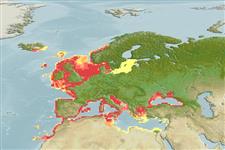| Native range | All suitable habitat | Point map | Year 2100 |

|
| This map was computer-generated and has not yet been reviewed. |
| Trachinus draco AquaMaps Data sources: GBIF OBIS |
Utilização humana
Pescarias: pouco comercial; peixe desportivo: sim; Aquário: Aquários públicos
Phylogenetic diversity index
(Ref. 82805)
PD50 = 0.5059 many relatives (e.g. carps) 0.5 - 2.0 few relatives (e.g. lungfishes)
Nível Trófico
(Ref. 69278)
4.2 ±0.71 se; Based on food items.
Resiliência
(Ref. 69278)
Médio, tempo mínimo de duplicação da população 1,4 - 4,4 anos (Assuming tm=2-4)